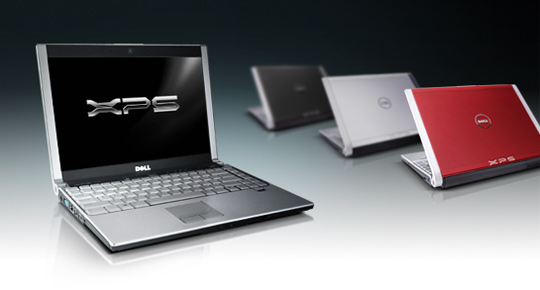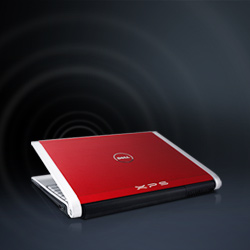Apple Lags PC-Makers In SubNotebook Category - New Thin Dell Raises The Bar
Tuesday, July 3, 2007
by Charles W. Moore
The current crop of MacBooks and MacBook Pros is great, but Apple is being left behind badly in the subnotebook category by its debatable decision not to replace the 12” PowerBook with an Intel - based subnotebook.
Meanwhile, Windows-PC makers keep rolling out some pretty nice compact and subcompact notebooks with Core 2 Duo power, the latest entry in the field being the new Dell XPS M1330, which Dell, is touting as “the world’s thinnest 13-inch notebook.” The XPS M1330is certainly thin, at least in it’s main body section at 2.31 cm (0.9”), although it thickens at the hinge end to 3.38 cm, which is actually thicker than a MacBook, which is a symmetrical 2.75 cm (1.08 inches).

I’ve always thought the obsession with thinness was more than a bit silly anyway, and counterproductive from an engineering perspective, requiring too many compromises in the design of internal components and making cooling less efficient. To my way of thinking, the 12” iBook and PowerBook represented a pretty decent dimensional package for subnotebook computers.
However, the Dell XPS M1330 does have the MacBook beat in terms of weight and its width dimension, being a svelte 3.97 pounds and measuring 31.8 cm wide, compared with the MacBook’s hefty 5.2 pound weight and 32.5 cm width. The MacBook is actually less deep, at 22.7 cm compared with the XPS M1330’s 23.8 cm depth.
At 3.97 pounds, the XPS M1330 is nearly a pound lighter than the erstwhile 12” PowerBook, although the latter had a smaller footprint at 27.7 cm wide and 21.9 cm deep, and was an even 3.0 cm thick.
Speaking of the 12” PowerBook, it has continued to command a premium price in the refurbished channel, selling for $hundreds more than newer and much faster refurb. MacBooks. I notice that this week there are no longer any Apple Certified Refurbished 12” PowerBooks being offered at the Apple Store, so supply must be petering out.
Rumors persist about Apple working on a NAND flash memory based MacBook Pro subnotebook, and my take on that is that there is probably substance to it, especially being as Samsung last week announced that it has begun mass producing the industry’s first 1.8-inch, 64gb solid state notebook drive (SSD).
SSDs promise far greater reliability and service ruggedness thanks to having no moving parts, feature faster boot times and faster application start-up times than hard disk drives. SSDs can also improve battery life by up to 20 percent in notebooks, according to Samsung.
The Samsung 64GB SSD consists of 64 eight Gigabit (Gb) single-level cell flash memory chips. Use of 51nm process technology permits fabrication of much smaller components, with each chip having circuitry 1/2500th the width of a human hair.
This all sounds good, and I think that if Apple does produce an SSD based MacBook Pro subnotebook they will sell a ton of them, but I also continue to maintain that they are missing the boat by not offering a conventional hard drive based Intel-powered subnotebook like the Dell XPS M1330 for Road Warriors who don’t want to give up the versatility and flexibility of a full-fledged portable computer in order to get a comfortably carriable package.

Another area where the XPS M1330 has an advantage is in choice of color. Now, don’t get me wrong; I’m partial to white computers and have nothing against black ones, but there is a case to be made for having choices wider than limousine or wedding dress/tuxedo color schemes.
Dell is pitching its notebook lines a “haute couture” “hot computers” with bright and striking livery options such as Sunshine Yellow and Flamingo Pink, although the XPS M1330 flagship ultra-portable comes in just three colors: Tuxedo Black, Pearl White or Crimson Red. Ironically, it was Apple that pioneered colorful computers with the original iMacs and iBooks, before retreating into the world of basic white, black, and metallic.

Engineering-wise, the Dell XPS M1330 sports a durable and light magnesium alloy chassis with brushed aluminum accents. CPU options include 1.50 GHz, 1.80 GHz, 2.0 GHz, and 2.2 GHz Intel Core 2 Duo processors. The base 1.50 GHz model comes with 2M of L2 Cache and a 667MHz Frontside bus, the 1.80GHz unit with ,2M L2 Cache and 800MHz FSB, and the two high end models with 4M of L2 Cache and an 800MHz FSB. Up to Up to 4GB of shared20 Dual Channel 667MHz DDR2 SDRAM is supported across the board. The XPS M1330 should be no slouch power-wise.
Apple use in the MacBook of Intel’s GMA 950 integrated graphics technology has been a bête noir for some critics, being as it leeches off some 80 MB of system RAM for video support an offers mediocre performance for gaming and high-end graphics. The XPS M1330 also uses Intel integrated graphics in the lower-end models, in this case the Intel Integrated Graphics Media Accelerator X3100, but also offered as an option is an NVIDIA GeForce Go 8400M GS with 128MB dedicated DDR3 graphics memory. Apple should look into offering MacBook-users a choice in this context as well.
Display options with the XPS M1330 include a conventionally CCFL backlit 13.3” WXGA display with TrueLife (available with 2.0MP camera) , and an LED backlit 13.3” WXGA display with TrueLife (available with 0.3 MP camera). The MacBook is only available with 13”3” CCFL backlit displays, although it is expected that the next revision will have LED backlighting.
The XPS M1330 comes standard with a 120GB, 5400 RPM SATA Hard Drive, but up to a 200 GB 7200 RPM HD can be specified, and interestingly also a 32GB a Solid State hard drive (SSD).
Slot-Load DVD+/-RW Drive optical drives are take care of removable media chores.
Rounding out the XPS M1330’s equipment spec are 2 USB 2.0 compliant 4-pin connectors. one IEEE 1394a (FireWire 400) port, an RJ45 Ethernet port (10/100), an ExpressCard 54 mm slot, an
8-in-1 removable memory card reader, Stereo in & headphone/speaker out (x2) audio jacks and dual digital array mics. This outclasses the MacBook, which supports neither ExpressCard or removable memory cards.
In fairness, the base Dell XPS M1330 starts at $1,299 - $200 more than the entry-level MacBook, but even compared with the middle-spec 2.16 GHz White MacBook, the new Dell machine clearly has thrown down the gauntlet and raised the bar specification-wise, while coming in at more than a pound (in this instance in excess of 25%) lighter.
As I put the finishing touches on this commentary, the latest Apple ‘Book rumor on the Mac Web is that Apple will be introducing slimmer MacBooks with iPhone-like multi-touch functionality built into their touchpads later in 2007. If something like that comes to pass, I expect it will be a nice upgrade, although I’m skeptical about the “thinner” part. The iBook form factor is only a little more than a year old, and Apple has been inclined to hang on to case designs for much longer than that in recent years. The MacBook’s iBook predecessor retained essentially the same form factor for more than five years.
On the other hand, perhaps this thinner MacBook with a multi-touch touchpad will actually turn out to be the long-anticipated subcompact MacBook Pro. If I were betting, that’s the way I would lean.
Note: Letters to PowerBook Mystique Mailbag may or may not be published at the editor's discretion. Correspondents' email addresses will NOT be published unless the correspondent specifically requests publication. Letters may be edited for length and/or context.
Opinions expressed in postings to PowerBook Mystique MailBag are owned by the respective correspondents and not necessarily shared or endorsed by the Editor and/or PowerBook Central management.
If you would prefer that your message not appear in PowerBook Mystique Mailbag, we would still like to hear from you. Just clearly mark your message "NOT FOR PUBLICATION," and it will not be published.
CM